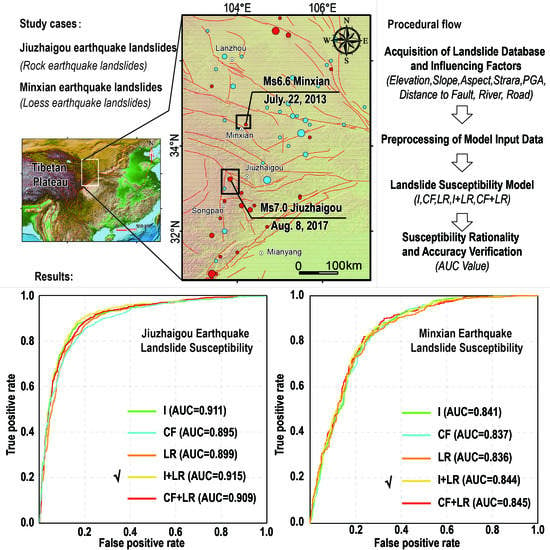Applicability of Susceptibility Model for Rock and Loess Earthquake Landslides in the Eastern Tibetan Plateau
Abstract
:1. Introduction
2. Background of Study Area
2.1. Jiuzhaigou Earthquake
2.2. Minxian Earthquake
3. Material and Method
3.1. Acquisition of Landslide Database and Influencing Factors
3.2. Preprocessing of Model Input Data
3.3. Landslide Susceptibility Model
3.3.1. Information Model (I)
3.3.2. Certainty Factor Model (CF)
3.3.3. Logistic Regression Model (LR)
3.3.4. Coupling Model I + LR
3.3.5. Coupling Model CF + LR
3.4. Rationality and Accuracy Verification of Susceptibility Results
4. Results
4.1. Distribution Maps of Landslide Susceptibility
4.2. Accuracy of Landslide Susceptibility Models
5. Discussion
6. Conclusions
- (1)
- The Jiuzhaigou landslides were mainly distributed in areas of limestone and dolomite. The Minxian landslides were mainly distributed in the area where the underlying bedrocks are conglomerate and sandstone.
- (2)
- The influencing factors adopted to calculate the susceptibility of rock landslides or loess landslides were reasonable, and the high AUC value suggested that they are suitable for the universal model.
- (3)
- For the distribution of susceptibility, most models fit the rules proposed by Tolga [56], except for the LR model. The landslide susceptibility distribution map calculated from the coupling models was more reasonable than that derived from their single models.
- (4)
- For prediction accuracy, the coupling models were generally more accurate than their single models. The prediction accuracy of the I + LR model was high in both rock and loess areas, which have high or moderate ground motion parameters.
Author Contributions
Funding
Data Availability Statement
Acknowledgments
Conflicts of Interest
References
- Liu, G.R.; Yan, E.C.; Lian, C. Discussion on Classification of Landslides. J. Eng. Geol. 2002, 10, 339–342, (In Chinese with English abstract). [Google Scholar]
- Xu, Y.R.; Liuzeng, J.; Allen, M.B.; Zhang, W.H.; Du, P. Landslides of the 1920 Haiyuan earthquake, northern China. Landslides 2020, 18, 935–953. [Google Scholar] [CrossRef]
- Hong, Q. South segment of Minjiang fault and Diexi earthquake in 1933. Earthq. Res. China 2000, 15, 333–338. [Google Scholar]
- Yin, Y.P.; Wang, F.W.; Sun, P. Landslide hazards triggered by the 2008 Wenchuan earthquake, Sichuan, China. Landslides 2009, 6, 139–152. [Google Scholar] [CrossRef]
- Chen, X.L.; Yu, L.; Wang, M.M.; Li, J.Y. Brief communication: Landslides triggered by the Ms 7.0 Lushan earthquake. Chin. Nat. Hazards Earth Syst. Sci. 2013, 1, 3891–3918. [Google Scholar] [CrossRef]
- Zheng, W.J.; Min, W.; He, W.G.; Ren, Z.K.; Liu, X.W.; Wang, A.G.; Xu, C.; Li, F. Distribution of the Related Disaster and the Causative Tectonic of the Minxian-Zhangxian Ms 6.6 Earthquake on July 22, 2013, Gansu, China. Seismol. Geol. 2013, 35, 604–615. [Google Scholar] [CrossRef]
- Chen, X.L.; Liu, C.G.; Wang, M.M.; Zhou, Q. Causes of unusual distribution of coseismic landslides triggered by the Mw 6.1 2014 Ludian, Yunnan, China earthquake. J. Asian Earth Sci. 2018, 159, 17–23. [Google Scholar] [CrossRef]
- Fan, X.M.; Scaringi, G.; Xu, Q.; Zhang, W.W.; Dai, L.X.; Li, Y.S.; Pei, X.J.; Yang, Q.; Huang, R.Q. Coseismic Landslides Triggered by the 8th August 2017 MS 7.0 Jiuzhaigou Earthquake (Sichuan, China): Factors Controlling Their Spatial Distribution and Implications for the Seismogenic Blind Fault identification. Landslides 2018, 15, 967–983. [Google Scholar] [CrossRef]
- Guzzetti, E.; Carrara, A.; Cardinali, M.; Reichenbach, P. Landslide hazard evaluation: A review of current techniques and their application in a multi-scale study, Central Italy. Geomorphology 1999, 31, 181–216. [Google Scholar] [CrossRef]
- Cao, J.; Zhang, Z.; Wang, C.; Liu, J.; Zhang, L. Susceptibility assessment of landslides triggered by earthquakes in the Western Sichuan Plateau. Catena 2019, 175, 63–76. [Google Scholar] [CrossRef]
- Dai, F.C.; Lee, C.F.; Li, J.; Xu, Z.W. Assessment of landslide susceptibility on the natural terrain of Lantau Island, Hong Kong. Environ. Geol. 2001, 40, 381–391. [Google Scholar] [CrossRef]
- Shao, X.Y.; Ma, S.Y.; Xu, C.; Zhang, P.F.; Wen, B.Y.; Tian, Y.Y.; Zhou, Q.; Cui, Y. Planet image-based inventorying and machine learning-based susceptibility mapping for the landslides triggered by the 2018 Mw6.6 Tomakomai, Japan earthquake. Remote Sens. 2019, 11, 978. [Google Scholar] [CrossRef] [Green Version]
- Caccavale, M.; Matano, F.; Sacchi, M. An integrated approach to earthquake-induced landslide hazard zoning based on probabilistic seismic scenario for Phlegrean Islands (Ischia, Procida and Vivara), Italy. Geomorphology 2017, 295, 235–259. [Google Scholar] [CrossRef]
- Ma, S.Y.; Xu, C.; Tian, Y.Y.; Xu, X.W. Application of logistic regression model for hazard assessment of earthquake-triggered landslides: A case study of 2017 Jiuzhaigou (China) Ms7.0 event. Seismol. Geol. 2019, 41, 162–177. [Google Scholar] [CrossRef]
- Dreyfus, D.K.; Rathje, E.M.; Jibson, R.W. The influence of different simplified sliding-block models and input parameters on regional predictions of seismic landslides triggered by the Northridge earthquake. Eng. Geol. 2013, 163, 41–54. [Google Scholar] [CrossRef]
- Chen, G. Landslide Susceptibility Analysis in the Middle Reach of Bailong River Basin Based on Statistical Models and In-Situ Experiment. Ph.D. Thesis, Lanzhou University, Lanzhou, China, 9 December 2019. (In Chinese with English Abstract). [Google Scholar]
- Aditian, A.T.; Kubota, T.; Shinohara, Y. Comparison of GIS-based landslide susceptibility models using frequency ratio, logistic regression, and artificial neural network in a tertiary region of Ambon, Indonesia. Geomorphology 2018, 318, 101–111. [Google Scholar] [CrossRef]
- Yin, K.L.; Yan, T.Z. Statistical Prediction models for slope instability of metamorphosed rocks. In Proceedings of the 5th International Symposium on Landslides, Lausanne, Switzerland, 10–15 July 1988; Balkema: Rotterdam, The Netherlands, 1988; pp. 1269–1272. [Google Scholar]
- Lan, H.X.; Wu, F.Q.; Zhou, C.H.; Wang, S.J. Analysis on susceptibility of gis based landslide triggering factors in Yunnan Xiaojiang watershed. Chin. J. Rock Mech. Eng 2002, 21, 1500–1506, (In Chinese with English Abstract). [Google Scholar]
- Tien Bui, D.; Shahabi, H.; Shirzadi, A.; Chapi, K.; Alizadeh, M.; Chen, W.; Mohammadi, A.; Ahmad, B.; Panahi, M.; Hong, H. Landslide Detection and Susceptibility Mapping by AIRSAR Data Using Support Vector Machine and Index of Entropy Models in Cameron Highlands, Malaysia. Remote Sens. 2018, 10, 1527. [Google Scholar] [CrossRef] [Green Version]
- Ilia, I.; Tsangaratos, P. Applying weight of evidence method and sensitivity analysis to produce a landslide susceptibility map. Landslides 2016, 13, 379–397. [Google Scholar] [CrossRef]
- Ayalew, L.; Yamagishi, H. The application of GIS-based logistic regression for landslide susceptibility mapping in the Kakuda-Yahiko Mountains, Central Japan. Geomorphology 2005, 65, 15–31. [Google Scholar] [CrossRef]
- Xu, C.; Xu, X.W.; Dai, F.C.; Wu, Z.D.; He, H.L.; Shi, F.; Wu, X.Y.; Xu, S.N. Application of an incomplete landslide inventory, logistic regression model and its validation for landslide susceptibility mapping related to the May 12, 2008, Wenchuan earthquake of China. Nat. Hazards 2013, 68, 883–900. [Google Scholar] [CrossRef]
- Xu, C.; Xu, X.W. Logistic regression model and its validation for hazard mapping of landslides triggered by Yushu earthquake. J. Eng. Geol. 2012, 20. [Google Scholar] [CrossRef]
- Luo, L.G.; Pei, X.J.; Huang, R.Q.; Pei, Z.; Zhu, L. Landslide susceptibility assessment by GIS based on certainty factor and logistic regression model in Jiuzhaigou scenic area. J. Eng. Geol. 2020, 1–11. [Google Scholar] [CrossRef]
- Fan, Z.Y.; Gou, X.F.; Qin, M.Y.; Fan, Q.; Yu, J.L.; Zhao, J.J. Information and Logistic Regression Models based Coupling Analysis for Susceptibility of Geological Hazards. J. Eng. Geol. 2018, 26, 340–347. [Google Scholar] [CrossRef]
- Guo, Z.Z.; Yin, K.L.; Huang, F.M.; Fu, S.; Zhang, W. Evaluation of landslide susceptibility based on landslide classification and weighted frequency ratio model. Chin. J. Rock Mech. Eng. 2019, 38, 287–300. [Google Scholar] [CrossRef]
- Yang, G.; Xu, P.H.; Cao, C.; Zhang, W.; Lan, Z.G.; Chen, J.Q.; Dong, X.J. Assessment of Regional Landslide Susceptibility Based on Combined Model of Certainty Factor Method. J. Eng. Geol. 2019, 27, 1153–1163. [Google Scholar] [CrossRef]
- Pham, B.T.; Nguyen, T.T.; Qi, C.C.; Phong, T.V.; Dou, J.; Ho, L.S.; Le, H.V.; Prakash, I. Coupling RBF-based Neural Network with Ensemble Learning Techniques for Landslide Susceptibility Mapping. Catena 2020, 195. [Google Scholar] [CrossRef]
- Su, Q.M. Research on Spatial Distribution Characteristics of Geologic Disaster and Landslide Susceptibility Assessment in Huoxi Coalfield. Ph.D. Thesis, Taiyuan University of Technology, Taiyuan, China, 13 June 2017. (In Chinese with English Abstract). [Google Scholar]
- Guo, J.Q.; Peng, D.; Cao, J.; Yang, J.Y. Geomorphology and quaternary geology in Jiuzhai Valley. Acta Geol. Sichuan 2000, 20, 183–192, (In Chinese with English abstract). [Google Scholar]
- Guo, X.Y.; Fu, B.H.; Du, J.; Shi, P.L.; Li, J.X.; Li, Z.; Du, J.X.; Chen, Q.Y.; Fu, H. Monitoring and Assessment for the Susceptibility of Landslide Changes After the 2017 Ms 7.0 Jiuzhaigou Earthquake Using the Remote Sensing Technology. Front. Earth. Sci. 2021, 9, 633117. [Google Scholar] [CrossRef]
- Wu, W.Y.; Wang, X.Q.; Deng, F. Compilation and Spatial Analysis of Co-seismic Landslide Inventory by Using High-resolution Remote Sensing Images in Earthquake Emergency Response-An Example of the Jiuzhaigou Ms 7.0 Earthquake on August 8, 2017. Technol. Earthq. Disaster Prev. 2017, 12, 815–825, (In Chinese with English Abstract). [Google Scholar]
- Dai, L.X.; Xu, Q.; Fan, X.M.; Chang, M.; Yang, Q.; Yang, F.; Ren, J. A preliminary study on spatial distribution patterns of landslides triggered by Jiuzhaigou earthquake in Sichuan on August 8th, 2017, and their susceptibility assessment. J. Eng. Geol. 2017. [Google Scholar] [CrossRef]
- Fan, X.M.; Yunus, A.P.; Scaringi, G.; Catani, F.; Subramanian, S.S.; Xu, Q.; Huang, R.Q. Rapidly evolving controls of landslides after a strong earthquake and implications for hazard assessments. Geophys. Res. Lett. 2020. [Google Scholar] [CrossRef]
- Wu, C.H.; Cui, P.; Li, Y.S.; Irasema, A.A.; Huang, C.; Yi, S.J. Seismogenic fault and topography control on the spatial patterns of landslides triggered by the 2017 Jiuzhaigou earthquake. J. Mt. Sci. 2018, 015, 793–807. [Google Scholar] [CrossRef]
- Dong, X.J.; Xu, Q.; She, J.X.; Li, W.L.; Liu, F.; Zou, X.X. Preliminary study on interpretation of geological hazards in Jiuzhaigou based on multi-source remote sensing data. Geomat. Inf. Sci. Wuhan Univ. 2020, 45, 432–441. [Google Scholar] [CrossRef]
- He, W.G.; Zheng, W.J.; Wang, A.G.; Liu, X.W.; Zhang, B.; Liu, F.B.; Pang, W. New Activities of Lintan-Dang Fault and its Relation to Minxian-Zhangxian Ms 6.6 Earthquake. China Earthq. Eng. J. 2013, 35, 751–760. [Google Scholar] [CrossRef]
- Tian, Y.Y.; Xu, C.; Xu, X.W.; Chen, J. Detailed inventory mapping and spatial analyses to landslides induced by the 2013 Ms 6.6 Minxian earthquake of China. J. Earth Sci. 2016, 27, 1016–1026. [Google Scholar] [CrossRef]
- Wu, Z.J.; Sun, J.J.; Chen, Y.J.; Wang, Q.; Zhao, W.C. Analysis of disaster causing mechanism of loess landslides induced by the Minxian-Zhangxian Ms 6.6 earthquake, China. Jpn. Geotech. Soc. Spec. Publ. 2015, 1, 40–45. [Google Scholar] [CrossRef] [Green Version]
- Zheng, W.J.; Yuan, D.Y.; He, W.G.; Min, W.; Ren, Z.K.; Liu, X.W.; Wang, A.G.; Xu, C.; Ge, W.P.; Li, F. Geometric pattern and active tectonics in Southeastern Gansu province: Discussion on seismogenic mechanism of the Minxian-Zhangxian Ms 6.6 earthquake on 22 July 2013. Chin. J. Geophys. 2013. [Google Scholar] [CrossRef]
- Liu, S.P. Spatio-Temporal Evolution of Northeastern Tibetan Plateau: Integrated Provenance Study of the Guide, Lanzhou and Wushan-Tianshui Basins. Ph.D. Thesis, Lanzhou University, Lanzhou, China, 2015. (In Chinese with English Abstract). [Google Scholar]
- Zhuang, Y.; Xing, A.G.; Cheng, Q.G.; Li, D.S.; Xu, C.; Zhao, C. Characteristics and numerical modeling of a catastrophic loess flow slide triggered by the 2013 Minxian-Zhangxian earthquake in Yongguang village, Minxian, Gansu, China. Bull. Eng. Geol. Environ. 2019, 79. [Google Scholar] [CrossRef]
- Xu, C.; Xu, X.W.; Shyu, J.B.H.; Zheng, W.J.; Min, W. Landslides triggered by the 22 July 2013 Minxian-Zhangxian, China, Mw 5.9 earthquake: Inventory compiling and spatial distribution analysis. J. Asian Earth Sci. 2014, 92, 125–142. [Google Scholar] [CrossRef]
- Huang, R.Q.; Li, W.L. Research on development and distribution rules of geohazards induced by Wenchuan earthquake on 12th May 2008. Chin. J. Rock Mech. Eng. 2008, 27, 2585–2592. [Google Scholar] [CrossRef]
- Keefer, D.K. Statistical analysis of an earthquake-induced landslide distribution-the 1989 Loma Prieta, California event. Eng. Geol. 2000, 58, 231–249. [Google Scholar] [CrossRef]
- Talaei, R. Landslide Susceptibility Zonation Mapping Using Logistic Regression and its Validation in Hashtchin Region, Northwest of Iran. J. Geol. Soc. India. 2014, 84, 68–86. [Google Scholar] [CrossRef]
- Yin, K.L. Risk Analysis of Landslide Disaster; Science Press: Beijing, China, 2013; pp. 32–34. (In Chinese) [Google Scholar]
- Ba, Q.Q.; Chen, Y.M.; Deng, S.S.; Wu, Q.J.; Yang, J.X.; Zhang, J.Y. An improved information value model based on gray clustering for landslide susceptibility mapping. ISPRS Int. J. Geo-Inf. 2017, 6, 18. [Google Scholar] [CrossRef]
- Shortliffe, E.H.; Buchanan B, G. A model of inexact reasoning in medicine. Math. Biosci. 1987, 23, 351–379. [Google Scholar] [CrossRef]
- Tang, C.; Ma, G.C. Small regional geohazards susceptibility mapping based on geomorphic unit. Sci. Geogr. Sin. 2015, 35, 91–98, (In Chinese with English Abstract). [Google Scholar]
- Conoscenti, C.; Angileri, S.; Cappadonia, C.; Rotigliano, E.; Agnesi, V.; Maerker, M. Gully erosion susceptibility assessment by means of GIS-based logistic regression: A case of Sicily (Italy). Geomorphology 2014, 204, 399–411. [Google Scholar] [CrossRef] [Green Version]
- Mathew, J.; Jha, V.K.; Rawat, G.S. Landslide susceptibility zonation mapping and its validation in part of Garhwal lesser Himalaya, India, using binary logistic regression analysis and receiver operating characteristic curve method. Landslides 2009, 6, 17–26. [Google Scholar] [CrossRef]
- Tolga, C.; Hakan, A.N.; Candan, G.; Harun, S.; Tamer, Y.D. Susceptibility assessments of shallow earthflows triggered by heavy rainfall at three catchments by logistic regression analyses. Geomorphology 2005, 72. [Google Scholar] [CrossRef]
- Swets, J.A. Measuring the accuracy of diagnostic systems. Science 1988, 240, 1285–1293. [Google Scholar] [CrossRef] [Green Version]
- Fawcett, T. An introduction to ROC analysis. Pattern Recognit. Lett. 2005, 27, 861–874. [Google Scholar] [CrossRef]
- Tian, Q.; Zhang, B.; Guo, J.F.; Liu, H.Z.; Chang, Z.L.; Li, Y.J.; Huang, F.M. Landslide susceptibility assessment based on the coupling model of information value and logistic regression. Sci. Technol. Eng. 2020, 20, 8460–8468, (In Chinese with English Abstract). [Google Scholar]

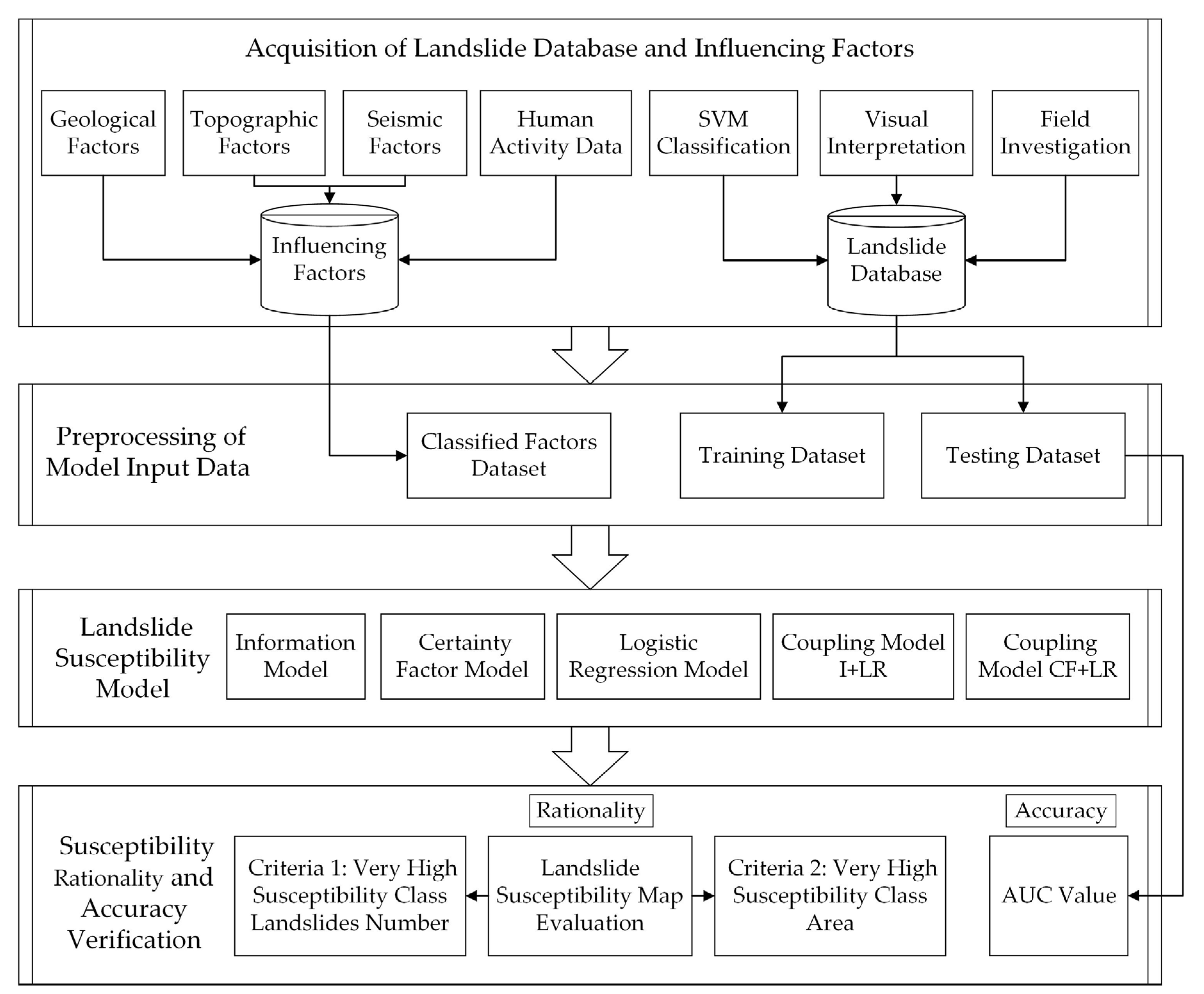

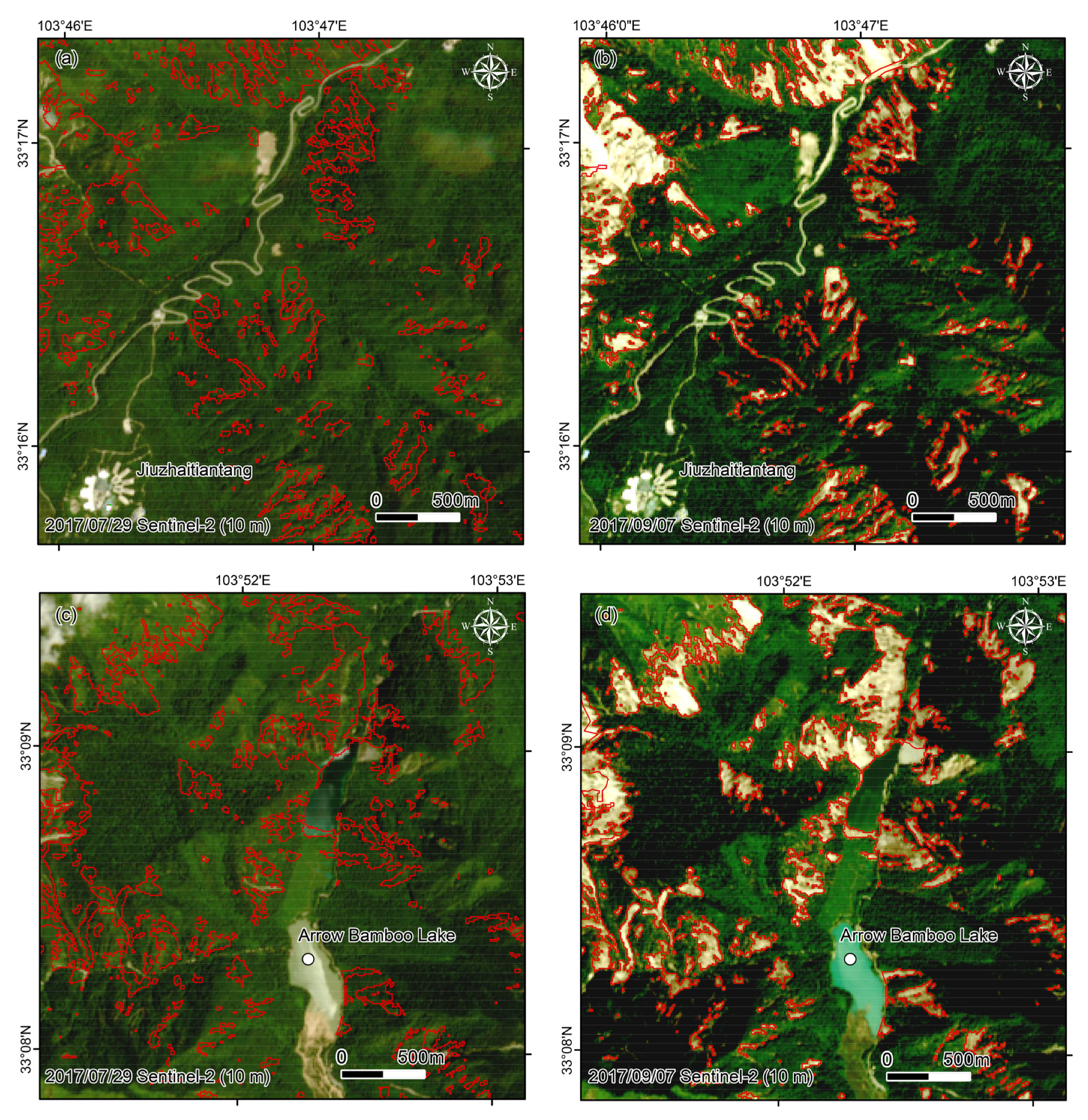


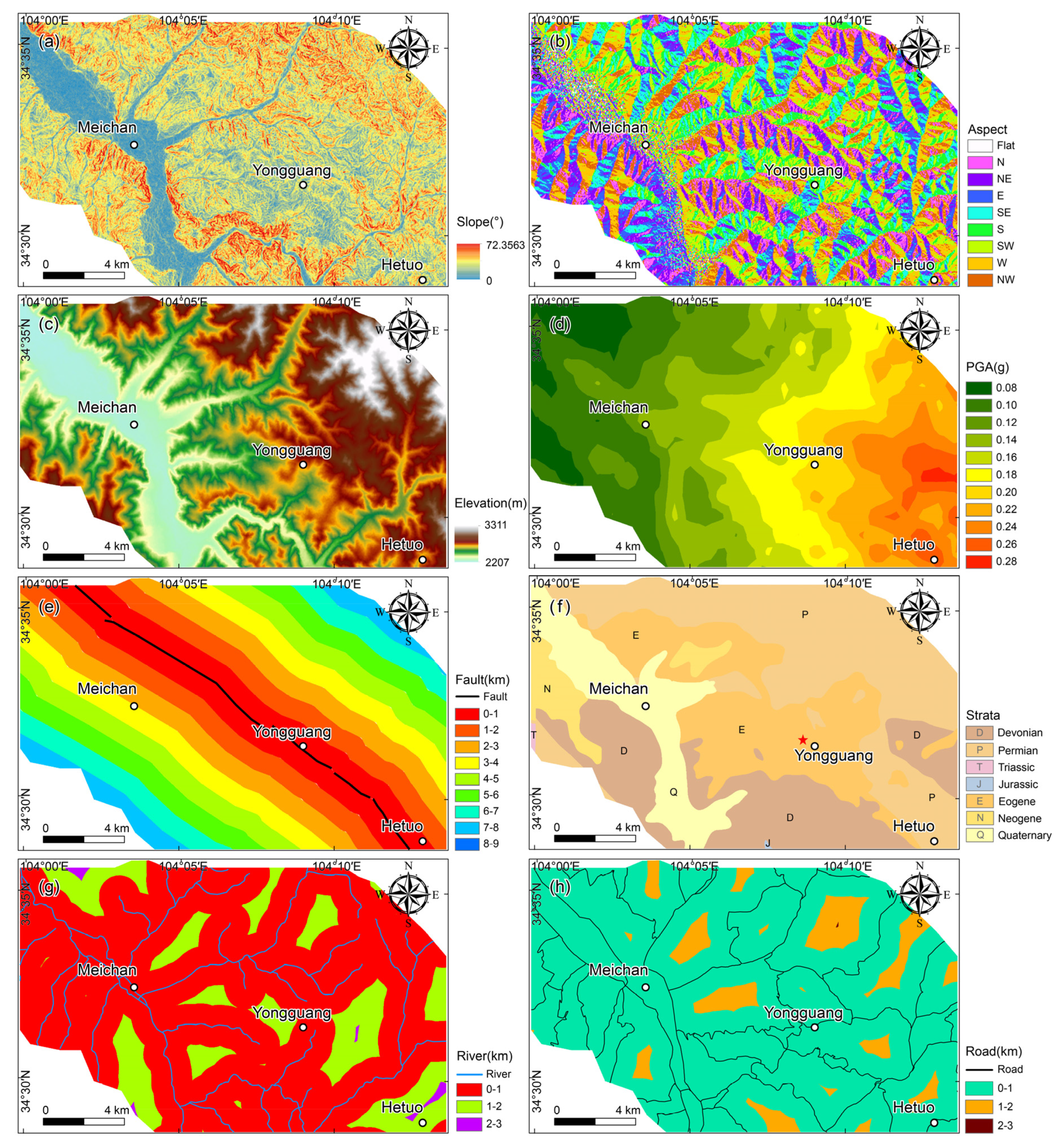
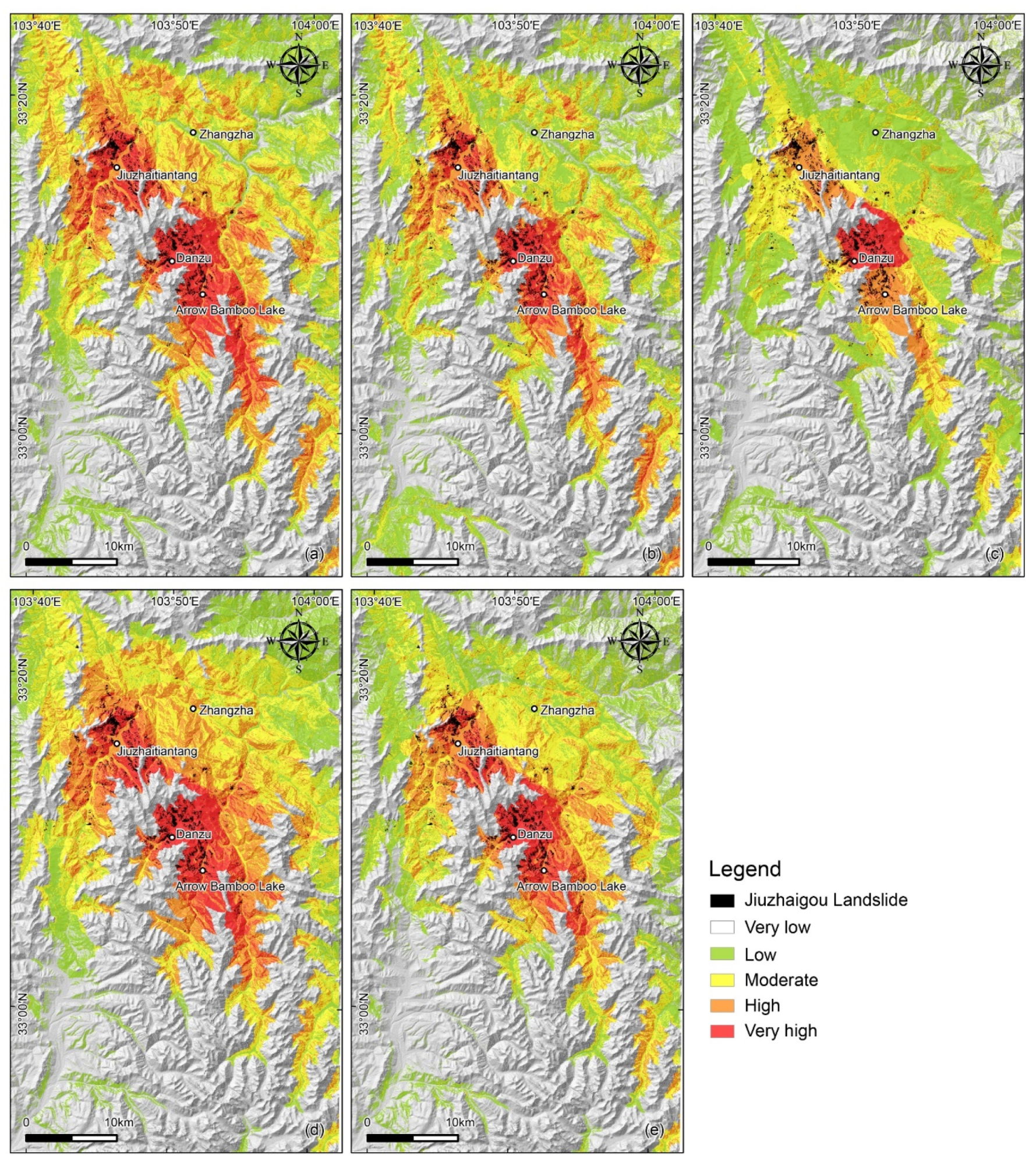
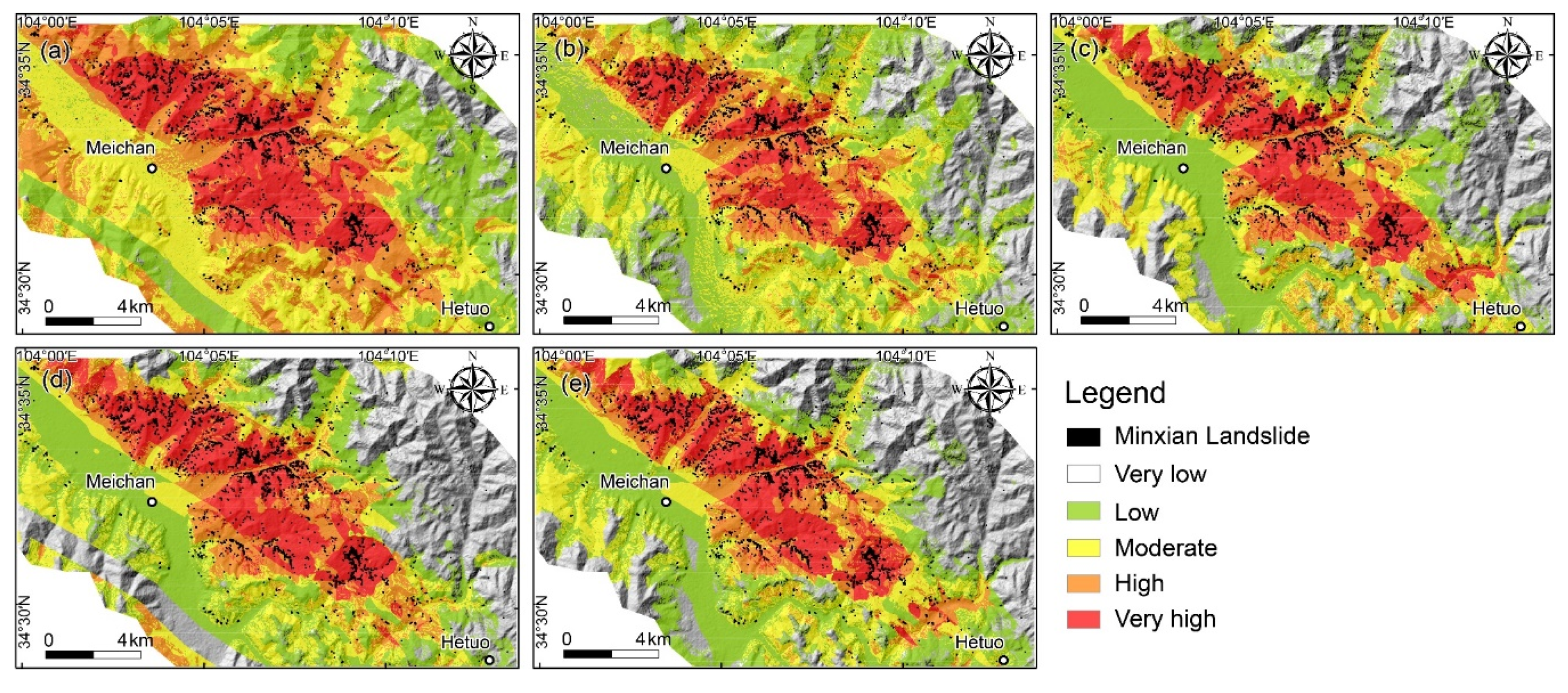
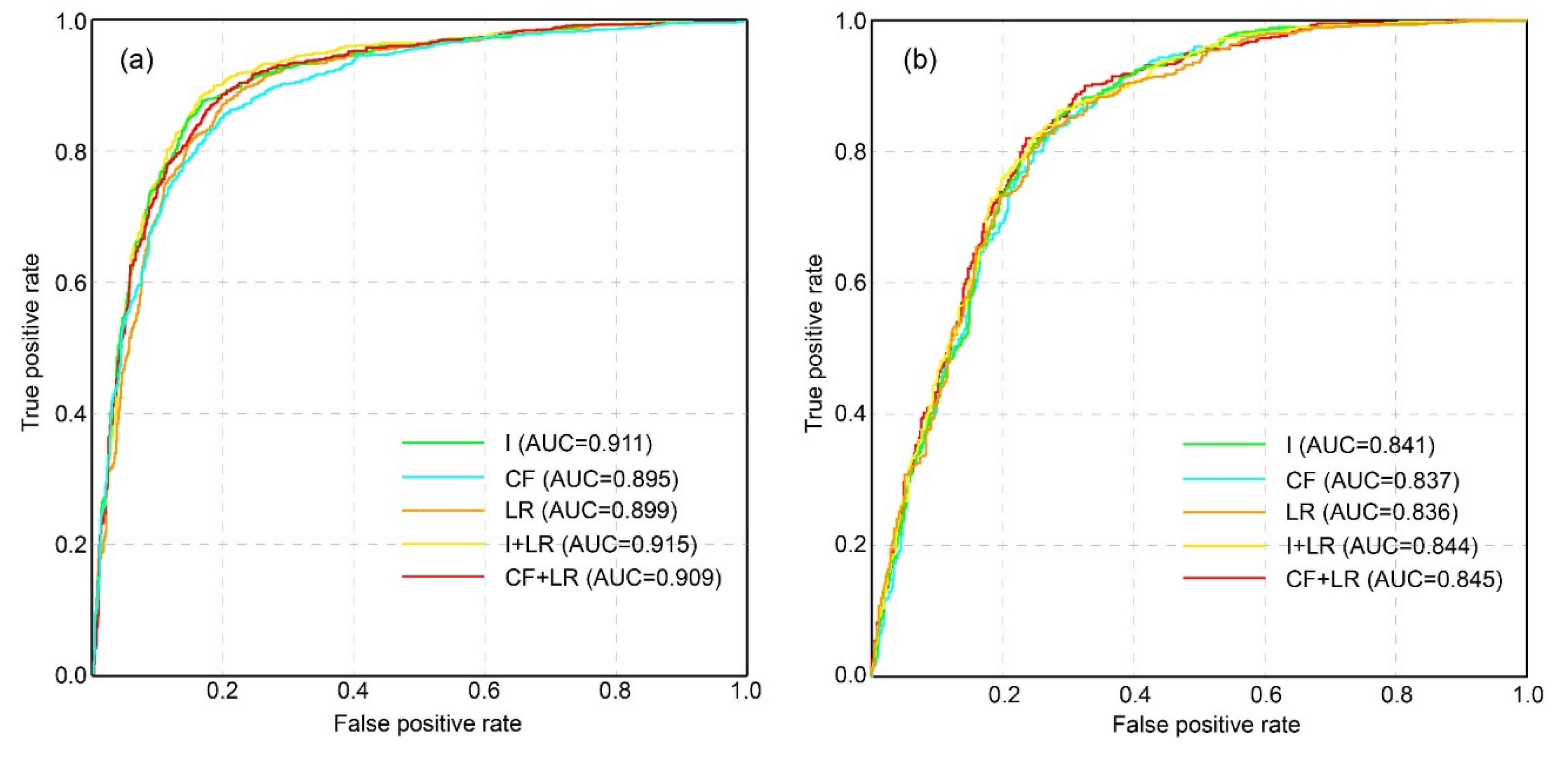
| No. | Strata | Lithology |
|---|---|---|
| D | Devonian | Biolithite with argillaceous limestone, layered dolomite |
| C | Carboniferous | Compacted limestone with dolomite and argillite |
| P | Permian | Shale, limestone, and dolomite |
| T | Triassic | Limestone, slate, sandstone |
| Q | Quaternary | Sand and gravel |
| No. | Strata | Lithology |
|---|---|---|
| D | Devonian | Silty slate, powder sandstone, slate |
| P | Permian | Carbon-containing slate, slate, sandstone, conglomerate |
| T | Triassic | Thick sandstone, slate, and a small amount of limestone |
| J | Jurassic | Conglomerate, carbonaceous shale clip coal, or oil shale |
| E | Eogene | Sandstone, conglomerate |
| N | Neogene | Sandstone, conglomerate, siltstone and sandy argillite |
| Q | Quaternary | Sand and gravel |
| Susceptibility | Percentage of Landslide Points/(%) | Percentage of Classification Area /(%) | LND/km2 | ||||||||||||
|---|---|---|---|---|---|---|---|---|---|---|---|---|---|---|---|
| I | CF | LR | I + LR | CF + LR | I | CF | LR | I + LR | CF + LR | I | CF | LR | I + LR | CF + LR | |
| Very low | 0.66 | 1.08 | 1.67 | 0.43 | 1.13 | 14.28 | 18.65 | 30.19 | 13.56 | 24.21 | 0.15 | 0.20 | 0.19 | 0.11 | 0.16 |
| Low | 1.87 | 3.64 | 5.49 | 1.54 | 2.75 | 23.22 | 30.73 | 36.74 | 22.65 | 27.56 | 0.27 | 0.40 | 0.50 | 0.23 | 0.34 |
| Moderate | 4.63 | 9.87 | 23.43 | 4.06 | 7.39 | 29.51 | 27.12 | 21.19 | 31.18 | 26.31 | 0.53 | 1.23 | 3.73 | 0.44 | 0.95 |
| High | 18.82 | 29.40 | 45.03 | 20.70 | 31.45 | 21.61 | 16.36 | 8.79 | 21.73 | 14.83 | 2.94 | 6.06 | 17.28 | 3.21 | 7.16 |
| Very high | 74.02 | 56.01 | 24.38 | 73.27 | 57.28 | 11.38 | 7.14 | 3.09 | 10.88 | 7.09 | 21.94 | 26.47 | 26.64 | 22.73 | 27.26 |
| Susceptibility | Percentage of Landslide Points/(%) | Percentage of Classification Area /(%) | LND/km2 | ||||||||||||
|---|---|---|---|---|---|---|---|---|---|---|---|---|---|---|---|
| I | CF | LR | I + LR | CF + LR | I | CF | LR | I + LR | CF + LR | I | CF | LR | I + LR | CF + LR | |
| Very low | 0.17 | 0.73 | 1.84 | 1.16 | 1.80 | 6.27 | 17.78 | 27.07 | 28.75 | 28.99 | 0.26 | 0.39 | 0.65 | 0.38 | 0.59 |
| Low | 0.99 | 3.69 | 7.38 | 6.09 | 6.39 | 20.46 | 28.42 | 26.18 | 24.87 | 27.38 | 0.46 | 1.23 | 2.68 | 2.33 | 2.22 |
| Moderate | 6.18 | 15.32 | 10.56 | 9.23 | 10.82 | 29.36 | 26.98 | 19.60 | 17.85 | 18.05 | 2.00 | 5.39 | 5.12 | 4.92 | 5.70 |
| High | 27.94 | 34.85 | 26.70 | 22.79 | 22.02 | 25.28 | 15.02 | 13.14 | 13.15 | 11.33 | 10.49 | 22.01 | 19.32 | 16.48 | 18.48 |
| Very high | 64.72 | 45.41 | 53.52 | 60.73 | 58.97 | 18.63 | 11.80 | 14.01 | 15.38 | 14.25 | 32.96 | 36.48 | 36.31 | 37.56 | 39.35 |
Publisher’s Note: MDPI stays neutral with regard to jurisdictional claims in published maps and institutional affiliations. |
© 2021 by the authors. Licensee MDPI, Basel, Switzerland. This article is an open access article distributed under the terms and conditions of the Creative Commons Attribution (CC BY) license (https://creativecommons.org/licenses/by/4.0/).
Share and Cite
Guo, X.; Fu, B.; Du, J.; Shi, P.; Chen, Q.; Zhang, W. Applicability of Susceptibility Model for Rock and Loess Earthquake Landslides in the Eastern Tibetan Plateau. Remote Sens. 2021, 13, 2546. https://doi.org/10.3390/rs13132546
Guo X, Fu B, Du J, Shi P, Chen Q, Zhang W. Applicability of Susceptibility Model for Rock and Loess Earthquake Landslides in the Eastern Tibetan Plateau. Remote Sensing. 2021; 13(13):2546. https://doi.org/10.3390/rs13132546
Chicago/Turabian StyleGuo, Xinyi, Bihong Fu, Jie Du, Pilong Shi, Qingyu Chen, and Wenyuan Zhang. 2021. "Applicability of Susceptibility Model for Rock and Loess Earthquake Landslides in the Eastern Tibetan Plateau" Remote Sensing 13, no. 13: 2546. https://doi.org/10.3390/rs13132546
APA StyleGuo, X., Fu, B., Du, J., Shi, P., Chen, Q., & Zhang, W. (2021). Applicability of Susceptibility Model for Rock and Loess Earthquake Landslides in the Eastern Tibetan Plateau. Remote Sensing, 13(13), 2546. https://doi.org/10.3390/rs13132546




